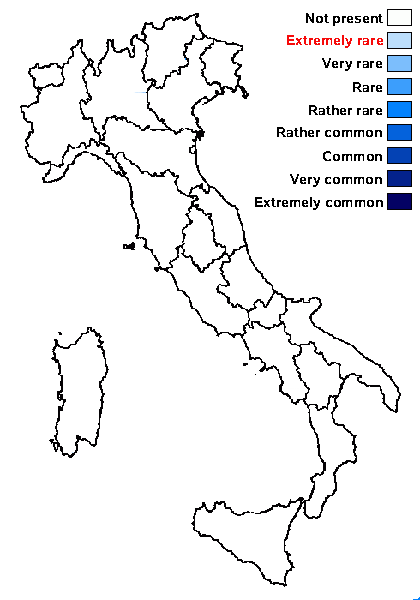Thelidium arnoldii Zschacke
Rabenhorst's Krypt.-Fl., 2nd ed., 9, 1. 1): 344, 347, fig. 169, 1933.
Synonyms:
Distribution:
Description: Thallus crustose, endosubstratic, whitish, usually poorly visible. Perithecia black, 0.4-0.5 mm across, at first completely immersed in pits in the rock and with only the ostiole visible, later slightly projecting and surrounded by a slight thalline swelling, leaving deep pits when they fall out. Involucrellum absent; exciple brown-black throughout; hamathecium of periphyses and periphysoids, interascal filaments absent; hymenial gel I+ red (I+ blue at very low concentrations of I), K/I+ blue. Asci 8-spored, ellipsoid to clavate, I-, fissitunicate, the wall thickened above, with an ocular chamber, dehiscent by extrusion of a delicate rostrum. Ascospores 1-septate and c. 32 x 16 μm or 3-septate and 33-40 x 16-20 μm, hyaline, ellipsoid. Photobiont chlorococcoid. Spot tests: K-, C-, KC-, P-, UV-. Chemistry: without lichen substances.Note: on limestone, most common at low elevations, with several records from the Eastern Alps (Austria); distribution poorly known, because often not distinguished from Th. incavatum; to be looked for in the Italian Alps.
Growth form: Crustose endolithic
Substrata: rocks
Photobiont: green algae other than Trentepohlia
Reproductive strategy: mainly sexual
Poorly known taxon in need of further study

Predictive model
Growth form: Crustose endolithic
Substrata: rocks
Photobiont: green algae other than Trentepohlia
Reproductive strategy: mainly sexual
Poorly known taxon in need of further study

Predictive model
 INDEX FUNGORUM
INDEX FUNGORUM
 GBIF
GBIF


